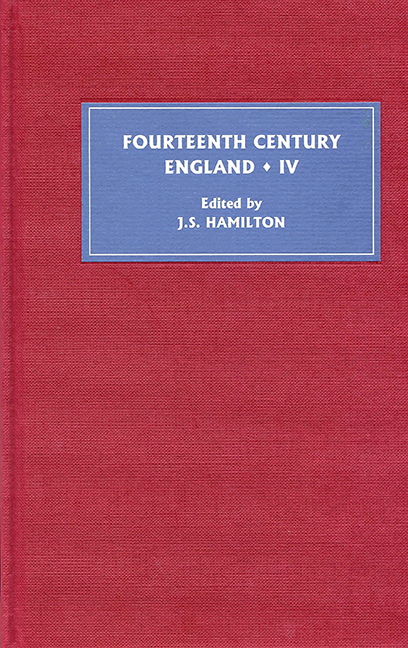Book contents
- Frontmatter
- Contents
- List of Illustrations
- Contributors
- Preface
- Abbreviations
- Who was St Thomas of Lancaster? New Manuscript Evidence
- ‘Hedging, Ditching and Other Improper Occupations’: Royal Landscapes and their Meaning under Edward II and Edward III
- Paying for the Wedding: Edward III as Fundraiser, 1332–3
- The Politics of Privilege: Thomas Hatfield and the Palatinate of Durham, 1345–81
- Agnes Maltravers (d. 1375) and her Husband John (d. 1364): Rebel Wives, Separate Lives, and Conjugal Visits in Later Medieval England
- Gendering Pastoral Care: John Mirk and his Instructions for Parish Priests
- Prosecution of the Statutes of Provisors and Premunire in the King's Bench, 1377–1394
- ‘Mercy and Truth Preserve the King’: Richard II's Use of the Royal Pardon in 1397 and 1398
- Aliens in the Pardons of Richard II
- ‘Too Flattering Sweet to be Substantial’? The Last Months of Thomas, Lord Despenser
- ‘O Prince, Desyre to be Honourable’: The Deposition of Richard II and Mirrors for Princes
- Regional Politics, Landed Society and the Coal Industry in North-East England, 1350–1430
Gendering Pastoral Care: John Mirk and his Instructions for Parish Priests
Published online by Cambridge University Press: 12 September 2017
- Frontmatter
- Contents
- List of Illustrations
- Contributors
- Preface
- Abbreviations
- Who was St Thomas of Lancaster? New Manuscript Evidence
- ‘Hedging, Ditching and Other Improper Occupations’: Royal Landscapes and their Meaning under Edward II and Edward III
- Paying for the Wedding: Edward III as Fundraiser, 1332–3
- The Politics of Privilege: Thomas Hatfield and the Palatinate of Durham, 1345–81
- Agnes Maltravers (d. 1375) and her Husband John (d. 1364): Rebel Wives, Separate Lives, and Conjugal Visits in Later Medieval England
- Gendering Pastoral Care: John Mirk and his Instructions for Parish Priests
- Prosecution of the Statutes of Provisors and Premunire in the King's Bench, 1377–1394
- ‘Mercy and Truth Preserve the King’: Richard II's Use of the Royal Pardon in 1397 and 1398
- Aliens in the Pardons of Richard II
- ‘Too Flattering Sweet to be Substantial’? The Last Months of Thomas, Lord Despenser
- ‘O Prince, Desyre to be Honourable’: The Deposition of Richard II and Mirrors for Princes
- Regional Politics, Landed Society and the Coal Industry in North-East England, 1350–1430
Summary
In some respects, as in ecclesiastical politics, for instance, the fourteenth century, when viewed as the outcome of the thirteenth century, may seem disappointing, something of a misfit or an anticlimax. … But in the realm of religious literature we can see, in the clearest and most satisfactory way, the achievement of the fourteenth century as the logical outcome of forces at work in the thirteenth century and earlier.
William Pantin made this observation in his 1955 survey of the fourteenth-century English church. In short, he had recognized a critical point: that – despite the inadequacies of the Avignon Papacy, the chaos of the Great Schism, and the heresy of John Wycliff – the church reforms of the thirteenth century had not been in vain. They had provided the impetus for the didactic pastoral manuals of the fourteenth and fifteenth centuries. By including such basic tenets as the Ten Commandments, Articles of Faith, Works of Mercy, Seven Vices and Virtues, and Seven Sacraments, these texts fulfilled the spirit of the thirteenth-century reforms by creating a foundation for a more learned clergy.
Moreover, by elucidating the quotidinal duties of pastoral care, pastoral manuals also shed light on another critical issue stressed by the reforms: that pastoral care was a gendered affair. Omnis utriusque sexus, one of the most famous decrees of the 1215 Fourth Lateran Council, required all Christians of proper age to make confession and take communion at least once a year, thereby emphasizing that both men and women needed pastoral attentions. Although this might seem an obvious assumption, the implications of the decree were profound. Ordinary parish priests were required to care for the souls of women as well as the souls of men. Yet, because women and men had different pastoral needs (or at least were perceived as having different pastoral needs), they required different pastoral care. Hence, the challenge for priests with cura animarum was not only to provide proper pastoral care, but to make that pastoral care gender appropriate.
- Type
- Chapter
- Information
- Fourteenth Century England IV , pp. 93 - 108Publisher: Boydell & BrewerPrint publication year: 2006

